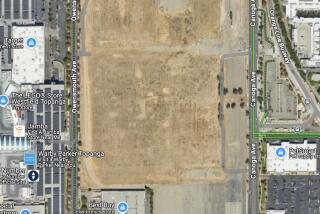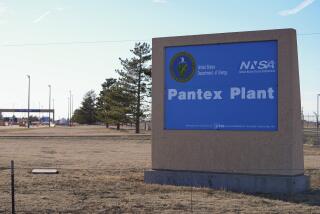Huge Military Toxic Cleanup Fund Urged
WASHINGTON — A national environmental group Wednesday urged Congress and President Bush to enact a $100-billion legislative package to pay for cleaning up thousands of hazardous waste sites at U.S. military bases.
The Boston-based National Toxic Campaign Fund released a report holding that there are more than 14,000 likely pollution sites at 1,579 Army, Navy and Air Force bases across the United States.
According to the group’s report, which it said was based in part on Department of Defense data, the Pentagon produced 900 million pounds of hazardous waste and 17 billion pounds of waste water, much of it toxic, in 1989.
About 100 of the sites listed by the group are on the Environmental Protection Agency’s Superfund list of unusually hazardous waste sites qualifying for special federal cleanup assistance. Potential funding for the other sites is limited.
For years, toxic troubles have plagued the El Toro Marine Corps Air Station, which is considered one of the worst dump sites in Orange County. Added to the nation’s Superfund list a year ago, the 5,000-acre base has at least 22 sites where hazardous materials were dumped or spilled, including some that are as large as 20 acres.
In a long-awaited agreement, the Defense Department last October signed a pact with the EPA saying that it would investigate the extent of the El Toro pollution and come up with a final cleanup plan by 1993.
The chemicals were dumped on the ground at the El Toro base mostly before the late 1970s, according to military records. Included are cancer-causing industrial solvents, polychlorinated biphenyls (PCBs), low-level radioactive waste, jet fuel, used motor oil and heavy metals.
Some petroleum materials were sprayed at the base for dust control for several decades, according to EPA and military records.
One cancer-causing solvent has tainted three agricultural wells near the base, and the Marines and the Orange County Water District have recently mounted separate cleanups to ensure the chemical doesn’t spread into drinking-water supplies.
The environmental group called on Congress to consider appropriating $10 billion during each of the next 10 years to clean up pollution on the bases and to study ways to prevent the problem from recurring.
“We believe it is time for the Pentagon to stop the chemical war at home,” said Toxic Campaign Fund President John O’Connor. “We have troops coming back that faced chemical attack and now face a toxic threat on Army bases.”
California has 1,713 potentially toxic sites at military bases, the largest number of any state, according to the report. Virginia ranked second, with 812.
The organization called 42 press conferences across the country Wednesday to outline its report. Four were in California, including one at a Lockheed facility in Burbank.
The National Toxic Campaign Fund noted that the Pentagon has allocated less than 0.5% of its total budget for toxic site cleanup. The $10-billion annual outlays proposed by the organization would increase that figure to about 3%.
Glenn Flood, a Pentagon spokesman, said that the Pentagon budgeted about $900 million during the current fiscal year for toxic waste sites and has requested $1.3 billion in its 1992 budget, which totals $300 billion.
Flood predicted that about half of the sites the Department of Defense has listed as possibly toxic would be removed from the list by the end of 1991.
More to Read
Sign up for Essential California
The most important California stories and recommendations in your inbox every morning.
You may occasionally receive promotional content from the Los Angeles Times.










